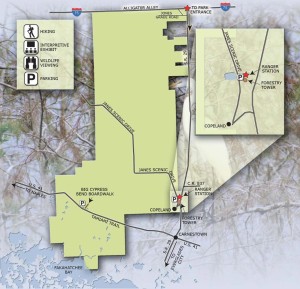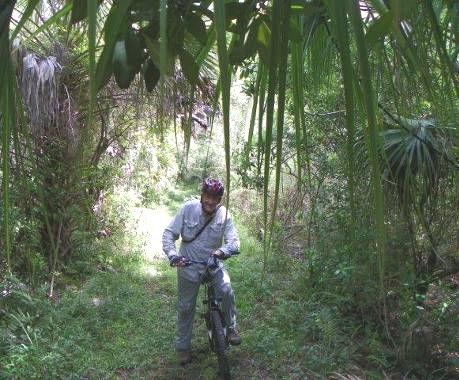by Anthony (Tony) Marx
For current trail conditions call the Fakahatchee park office 239-961-1925
I usually refer to biking off road as ‘Fat Tire’ or ‘Off-Road’ biking, as mention of ‘Mountain Biking’ in topographically-challenged Florida usually draws a snigger. But even when riding across our flat landscape off of paved roads, you need regular cruising tires or, better still, ‘fat tires’ because of sand, mud, and ruts.
I happen to like wilderness biking, because I cover greater distances than walking even if I bike in as far as possible, then hide my bike and start hiking. Plus, a bike carries your kit. This is especially handy in the Fakahatchee Strand Preserve State Park where bikers are welcome, with trails suitable for all riders.
Except for Janes Scenic Drive, itself a rough dirt road, the trails marked on the Park map require caution and riders should be observant for anything that could cause injury. Remember at 7-10 mph you approach a hazard much faster than walking. Show courtesy to hikers and be sure to dismount and stand aside to allow a rarely-seen vehicle to pass. These will usually be an ATV ridden by officials or the few ‘inholders’ occupying camps in the park.
Hazards include:
- Cypress ‘nubs’ or short stumps that may be hidden in the grass between or on the double track. Watch carefully as you cross from one side to the other.
- Low hanging branches and vines, some of which may have thorns. Wear helmet, eye protection and gloves.
- Alligators may pull themselves up on to the trail to sun themselves. If you see one ahead, approach to no closer than 20 feet and make a noise, wave your arms, stamp your feet. If it refuses to move, turn back.
- The Water Moccasin or Cotton Mouth snake is a venomous, semi-aquatic pit viper. Slow to bite, it sometimes is found resting on or alongside the trail where water is present nearby. It can grow to almost 3 feet; you don’t want to ride over it! It’s head is distinct from the neck, and it has faint markings which vary in color and are sometimes hidden under a muddy exterior. It blends in well with its surroundings. If you see a black or dark gray snake coiled or stationary, keep at least 3 feet away. Harmless grass and water snakes move out of your way fast.
- Except for palms, avoid riding over small branches and fallen vines as they may be armed with thorns which will puncture tires. I recommend inserting plastic tire liners on the inside of tires between the tube and outer cover, found at any bike shop or on the internet. They stop penetrations through the tread but not the sidewall.
 Finding your way when biking or hiking:
Finding your way when biking or hiking:
Janes Scenic Drive, West Main, East Main, Mud Tram and Jones Grade hiking trails are easily navigated as long as you keep on the trail. But if you visit the Uplands Trail ,or leave these trails to connect with others, it is essential you carry at minimum a reliable compass. If possible, a GPS unit downloaded with a topo map is best.
Even if carrying a compass to confirm direction, you will encounter off-shoot side trails made by ATV’s, driven by fire and official personnel during the year. While following what appears to be the main trail, consisting of double tracks across a grassy prairie, you will encounter the occasional old or new trail forking off, which may look more prominent because it was recently driven over. A check on your GPS screen will verify your position and direction.
Tony Marx is a Florida Master Naturalist and former Board Member.

